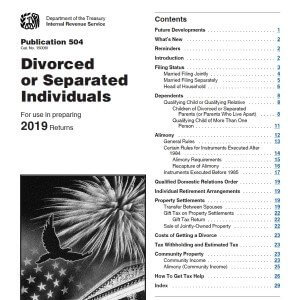Assignment of Estimated Tax Payments in a Divorce

Assignment of Estimated Tax Payments in a Divorce: IRS Publication 504, Divorced or Separated Individuals is one of our favorite reference sources for tax issues relevant to our divorced or separated clients.
How are tax refunds split in divorce? How are estimated tax payments assigned in a divorce?
If you and your spouse made joint estimated tax payments for 2019 but file separate returns, either of you can claim all of your payments, or you can divide them in any way on which you both agree. If you can’t agree, the estimated tax you can claim equals the total estimated tax paid times the tax shown on your separate return for 2019, divided by the total of the tax shown on your 2019 return and your spouse’s 2019 return. You may want to attach an explanation of how you and your spouse divided the payments.
Mason Comment 1: Although I am a CPA, I hire a CPA to do my taxes. Why? I can’t keep up with all of the changes in tax law. I have to worry about keeping up with divorce law. That’s enough for me. And, for you CPA’s, my accounting experience was in audit, not tax. I hope that makes sense.
Mason Comment 2: As you may know, we love IRS Publication 504 Divorced or Separated Individuals – 2019. It’s our “Cliff Notes” for our divorced and separated clients. Below are some quotes from that publication. Keep in mind the publication changes every year, so if these links are broken, there is likely a more recent version available. In future years, we may just make new pages and not update this one.
Tax Withholding and Estimated Tax
When you become divorced or separated, you usually will have to file a new Form W-4 with your employer to claim your proper withholding. If you receive alimony, you may have to make estimated tax payments.
Caution! If you don’t pay enough tax either through withholding or by making estimated tax payments, you will have an underpayment or estimated tax and you may have to pay a penalty. If you don’t pay enough tax by the due date of each payment, you may have to pay a penalty even if you are due a refund when you file your tax return.
For more information, see Pub. 505, Tax Withholding and Estimated Tax.
Joint estimated tax payments. If you and your spouse made joint estimated tax payments for 2019 but file separate returns, either of you can claim all of your payments, or you can divide them in any way on which you both agree. If you can’t agree, the estimated tax you can claim equals the total estimated tax paid times the tax shown on your separate return for 2019, divided by the total of the tax shown on your 2019 return and your spouse’s 2019 return. You may want to attach an explanation of how you and your spouse divided the payments.
If you claim any of the payments on your tax return, enter your spouse’s or former spouse’s SSN in the space provided on Form 1040 or 1040-SR. If you were divorced and remarried in 2019, enter your present spouse’s SSN in that space and enter your former spouse’s SSN, followed by “DIV” to the left of Schedule 3 (Form 1040 or 1040-SR), line 8.
Divorce & Taxes: Your 2019 Update
See Miles Mason, Sr.’s article which was the cover story for the Tennessee Bar Journal: Who Gets the Credit? Calculating the New Child Tax Credits in Your Parenting Plan.
See our Tennessee Family Law Blog post series on Divorce & Taxes 2019:
- IRS “Reminders” for Divorced or Separated Individuals
- IRS Requirements to Deduct Alimony on Your Tax Return
- General Tax Rules for Alimony After Divorce
- If You Qualify, You Want to File as Head of Household After Divorce
- 2019 Tax Law: Transfer of Property in a Divorce Settlement
- Are legal fees for divorce tax deductible in 2019?
- Dividing an IRA: 2019 Tax & Divorce Law
- Who Pays the Taxes on a QDRO Distribution after Divorce?
- Sale of Principal Residence after Divorce: 2019 Tax Law
- Assignment of Estimated Tax Payments in a Divorce









